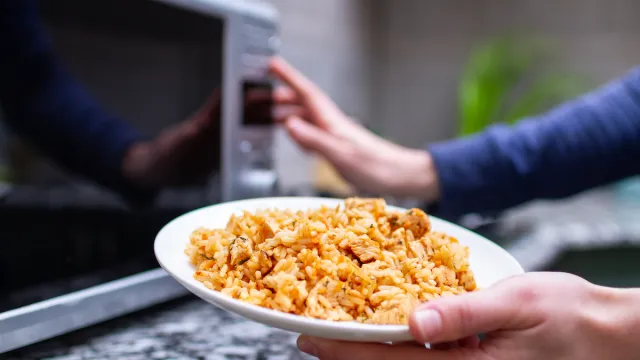Fact Check: Is It Safe to Reheat Rice? Here’s What Science Says

Reheating leftovers can be tricky business if you leave your food out for too long or don’t reheat it to its required temperature. Failing to meet either of these standards can lead to bacteria growth and consequently, foodborne illnesses, which can cause severe stomach pain, vomiting, diarrhea, and in more advanced cases, even death. And now, “reheated rice syndrome” has sparked a lively debate on TikTok with people questioning: Is it safe to reheat rice? Some content creators claim they’ve been eating reheated rice their whole lives and are healthy. However, scientific evidence shows some very real dangers of doing so.
RELATED: 6 Things You Should Never Leave Out on the Counter, Food Experts Warn.
According to the U.S. Department of Agriculture (USDA), food bacteria can grow at an alarming rate “between the temperatures of 40°F and 140°F,” also known as the “danger zone.” They say that hot foods such as soup must be kept at 140°F or warmer and then must be refrigerated within two hours of being cooked or “removed from an appliance keeping it warm.”
Cold perishable foods like raw meat or chicken salad must be kept at 40°F or colder. “Discard any cold leftovers that have been left out for more than 2 hours at room temperature (1 hour when the temperature is above 90 °F),” the FDA advises.
These rules apply to all sorts of foods, including those such as rice that are high in starch and carbohydrates. Unlike red meat or poultry, cooked rice may seem like an ingredient that can sit out for longer periods or doesn’t require specific reheating instructions. After all, uncooked rice doesn’t require refrigeration. However, that isn’t exactly the case.
In a recent TikTok video about “reheated rice syndrome,” microbiologist Marie (@mariedoesstuff) explains that rice contains organisms called “Bacillus cereus.” When the temperature of your cooked rice enters the danger zone, Bacillus cereus can create very dangerous toxins, which in turn, can make you gravely ill.
“So that means, don’t ever let your food that needs to be cooked sit out at room temperature,” Marie advises. “You don’t want it to be at that level of temperature for any length of time. It’s either cooked and you are eating it hot or it’s been refrigerated and it has stayed cold.”
To give followers a taste of just how potentially dangerous Bacillus cereus can be, Marie shares that the organism is on “the same branch of the microbial tree as things like anthrax and botulism and tetanus and C. diff.”
However, Bacillus cereus exists in uncooked rice and can stick around even after the rice has been cooked, according to the United Kingdom’s National Health Service (NHS). Likewise, a report published by the National Institute of Food and Agriculture (NIFA) also recognized the severity of Bacillus cereus and implicated both rice and fried rice as a “vehicle” of the organism.
As Marie explains, this is because the organism can create what’s known as an endospore, “which is when the bacterial cell decides to… hole up because there’s not enough water or the temperature isn’t right, or there’s not enough nutrients around, so it just kind of dries itself out into this almost, like, little seed,” waiting to unleash until the cooked grain hits room temperature.
Once it reaches the danger zone, those spores can expand into bacteria and release toxins into your rice, per the NHS. Reheating the rice at a higher temperature or for a longer time won’t kill off the bacteria, either.
“Reheating does nothing to the toxin. The toxin is still around and will still make you ill,” Marie warns.
RELATED: 7 Foods You Should Never Freeze, According to Experts.
Rather, the best thing rice lovers can do is immediately package their cooked rice and store it in the refrigerator so the grains don’t have the chance to reach room temperature. When you’re ready to reheat the rice, do so immediately so the internal temperature doesn’t reach higher than 40°F.
Per the NIFA report, for maximized cooling, avoid cramming containers with too much food, and don’t stack or crowd containers together as it can disrupt airflow.
If you want to be extra cautious, Marie says you can also rinse rice before cooking: “If you wash your rice, you won’t get rid of all the spores but you’ll reduce your chances of it happening.” She adds that washing will also get rid of any lingering dirt and metals.